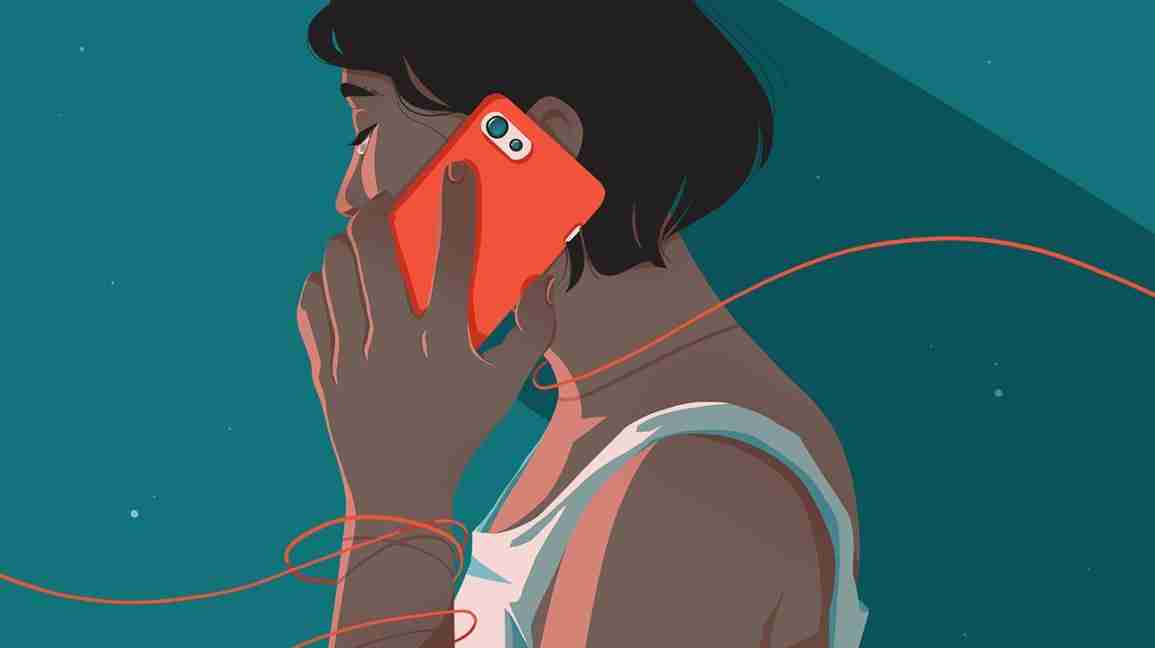An increasing number of hotline callers aren’t getting what they need — with alarming consequences.
In a time of crisis, 32-year-old Kaley — who struggles with anxiety and depression — Googled suicide hotline and called the first one that popped up.
“I was dealing with an emotional breakdown related to work. It got to a point with my job that I was unable to cope in a healthy way, and I didn’t have the mental health support I needed at the time,” she recalls.
“Something in me just snapped. I called a crisis hotline because, even though I had no plans to follow through, I was unable to ‘turn off’ the suicidal ideation. I needed to talk to someone.”
The response she got from the person on the other end of the phone, though, was shocking. “[They] suggested that the cure for my problem would be to go get my nails or hair done.”
It was a careless response to a mental health crisis, to say the least. “[The operator spoke] as if I hadn’t tried any version of retail therapy ‘self-care’ in the past, or as if that was all I needed to feel better.”
Luckily, Kaley took the necessary next steps to get herself feeling safe — she hung up on the hotline operator and headed to the hospital where she checked herself in.
Understandably, the experience left her with a bad taste in her mouth. She says, “Whoever was on the other end of the line was not trained to deal with people in acute crisis.”
Suicide hotlines are advertised as a saving grace for people in crisis. But what happens when the people who are supposed to be there for you let you down — or even make things worse?
Kaley’s nightmarish call is by no means a unique experience. Negative experiences with suicide and crisis hotlines appear to be an all-too-common phenomenon.
Many of the people I interviewed for this article reported being put on hold when calling a hotline — some for half an hour or more — while others were redirected to full voicemail inboxes, or given unhelpful advice like what Kaley received.
These hotlines are often touted as “the answer” for someone in crisis, but an increasing number of people struggling with their mental health are questioning whether or not they can be trusted.
And in a country where a suicide occurs
Picking up the phone and calling a hotline can be an important step when you’re in crisis, but we need to address the elephant in the room: A hotline also has its limits.
Realistically, these hotlines can’t offer everything.While each hotline is different, we must accept that they have unique limitations — some understaffed, some undertrained, and almost all are overburdened.
And while more options are emerging to address this need, including text-based options, this doesn’t always translate to better services.
Sam, 27, didn’t have much luck with the text-based option. “I used Crisis Text Line when I was struggling very intensely with anorexia nervosa. If you text ‘NEDA’ to crisis text line, which is the acronym for National Eating Disorders Association, the assumption is that you get someone competent around issues of disordered eating,” he says.
“Instead, when I shared what I was struggling with, it was essentially parroted back to me as, ‘What I’m hearing is, you’re struggling with an eating disorder.’ They then told me to use an online support group to connect with other people with eating disorders, sent me a link, and signed off.”
It doesn’t necessarily sound like a “bad” experience, until you hear what happened next. “When I clicked the link, it was broken,” he recalls. “It scares me that they didn’t bother checking the link before they sent it.”
At that point, with an unusable link to a support resource he wasn’t able to access, Sam was left exactly where he started.
Many advocates like Sam are now reluctant to use crisis lines, let alone recommend them without some amount of cautioning.
Callers like Sam expressed concerns around the approach that many operators use. The “parroting” that he described is all too common — also known as reflective listening — but it’s not necessarily the operator’s fault.
This technique is often taught by hotlines and chat services like Crisis Text Line. While the method is meant to help callers and texters feel heard and understood, it seems to mostly cause frustration.
“I’ve reached out to both the suicide and eating disorder hotlines and I’ve never had an experience where I didn’t feel like I was educating them or pretending that their resources were helpful,” says Lauren, 24, another caller who has experienced “parroting.”
“I totally get that they’re volunteers and there’s a limit to what they can do, but usually they end up just super obviously using reflective listening in a really obtuse and unhelpful way,” they add.
With responses like these, it’s no surprise that callers are beginning to lose faith in the resources that are portrayed as being critical for their survival.
“[Reflective listening] can be empathetic when used well,” Lauren explains. “But it’s usually like me saying: ‘I’m really overwhelmed’… and they respond with ‘So I hear you saying you’re really overwhelmed.’”
Lauren admits to having self-harmed or self-medicated after these unproductive calls. “There has to be a way to train differently. [A hotline is] obviously never going to be the same as therapy. But it’s not helpful at all at present,” they say.
While hotlines can be hit-or-miss — like any other mental health resource — it’s important to know that you have other ways of keeping yourself safe.
Samantha Levine, LCSW, of UCLA’s Behavioral Health Associates has some tips for people in crisis, whether or not they’ve called a hotline.
One thing she notes is the importance of identifying whether you’re having passive suicidal thoughts or plans to actually end your life.
“Many people have these passive thoughts about ending their life, but do not have a plan and are able to identify that it’s more a thought about wanting to end their painful or scary emotions rather than killing themselves,” she says.
“It’s important to help people understand that just because you are having these emotions, it doesn’t necessarily mean that you will lose control or act on your thoughts.”
Regardless, Levine urges people with a history of suicidal thoughts to take measures to ensure that they’re in a safe environment. “If there are weapons around, what can the person do to secure those weapons? Is there another location they can go to until the urge to harm themselves has passed? Can they involve someone else to help them?”
“One example may be, ‘I asked my uncle to secure my gun at his house and to not tell me where it was,’ or, ‘I went to my best friend’s house to watch a movie because I was having urges to self-harm,’” she continues.
The key here is making sure you aren’t alone with your thoughts and that you don’t have access to the tools you might use to act on them. And creating a line of communication by cluing in loved ones whenever possible can also be part of your safety plan, too.
However, she stresses the importance of going to the hospital if you think you might be in danger.
“If people do have a plan for hurting themselves or ending their lives in place, or if the thoughts about harming themselves intensify, I urge them to call 911 and go to the emergency room,” Levine says.
She also suggests looking into local urgent psychiatric care centers, which can be a great alternative to heading to the ER, if available in your city.
Whether you’re in crisis or not, there’s never a bad time to create a safety plan.
Vera Hannush, an operator for the LGBT National Hotline, deals with calls involving suicide often. As a newly appointed trainer at the hotline, she’s working to train operators to be able to properly handle suicidal callers and ensure the best care for them.
She echoes Levine’s sentiments of creating a safe environment and using coping skills to distract from negative thoughts. Another tip she mentions is having a future focus.
Hannush explains, “Is there anything that has helped them before if they have felt this way before? Can they think of something to do in the next hour/tomorrow (thus putting a future-focus)? Is there a safe space they can go to?”
Set plans in the future — both near and not-so-near — to refocus attention and create a game plan.
Hannush also recommends filling out a personal safety plan, offered by the hotline to outline safety measures, people to talk to, and coping skills that work for you.
Some coping skills might include:
- breathing exercises such as paced breathing
- practicing meditation and mindfulness (there are apps for this!)
- journaling (for example, writing a list of the reasons you’ve stayed alive, or what stops you from hurting yourself)
- exercising (even just going for a walk or trying a few yoga poses can help)
- watching or listening to something that makes you laugh
- getting out of the house (maybe going to a cafe or public place where you’re less likely to hurt yourself)
- talking to a family member or good friend
- using virtual self-care resources, like youfeellikeshit.com or Wysa
Keeping a list like this handy can be super helpful to reference when you’re in crisis or feel like you’re heading there. It can be much harder to think rationally and come up with sound ideas while you’re actually in an acute state.
While coping skills won’t “cure” a mental health crisis, they can help to deescalate it so that you can problem solve in a more stable point in the future.
All that said, there are amazing crisis line operators who do really help people when they need it. These people do save lives.
But in the event that a call doesn’t go the way you hoped it would, remember there are plenty of options you have to turn things around.
You got this.
Suicide prevention
- If you think someone is at immediate risk of self-harm or hurting another person:
- • Call 911 or your local emergency number.
- • Stay with the person until help arrives.
- • Remove any guns, knives, medications, or other things that may cause harm.
- • Listen, but don’t judge, argue, threaten, or yell.
- If you or someone you know is considering suicide, get help from a crisis or suicide prevention hotline. Try the National Suicide Prevention Lifeline at 800-273-8255.
Ashley Laderer is a writer who aims to break the stigma surrounding mental illness and make those living with anxiety and depression feel less alone. She’s based in New York, but you can often find her traveling elsewhere. Follow her on Instagram and Twitter.

